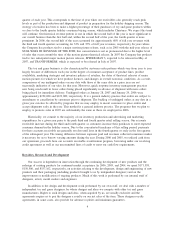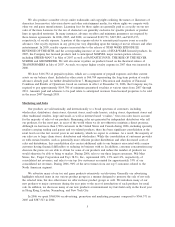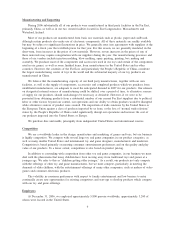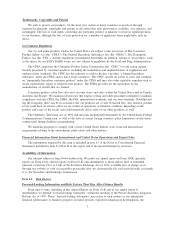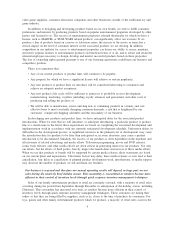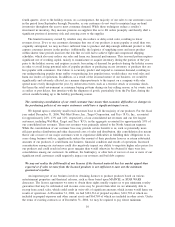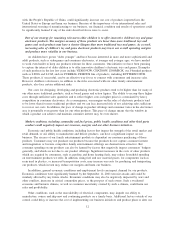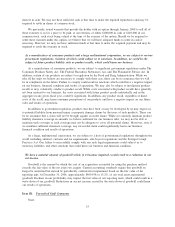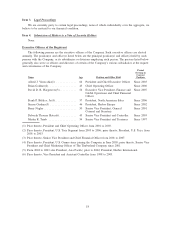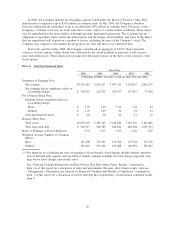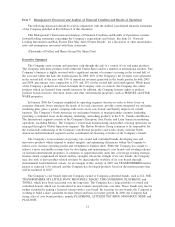Hasbro 2006 Annual Report Download - page 23
Download and view the complete annual report
Please find page 23 of the 2006 Hasbro annual report below. You can navigate through the pages in the report by either clicking on the pages listed below, or by using the keyword search tool below to find specific information within the annual report.with, the People’s Republic of China, could significantly increase our cost of products imported into the
United States or Europe and harm our business. Because of the importance of our international sales and
international sourcing of manufacturing to our business, our financial condition and results of operations could
be significantly harmed if any of the risks described above were to occur.
Part of our strategy for remaining relevant to older children is to offer innovative children’s toy and game
electronic products. The margins on many of these products are lower than more traditional toys and
games and such products may have a shorter lifespan than more traditional toys and games. As a result,
increasing sales of children’s toy and game electronic products may lower our overall operating margins
and produce more volatility in our business.
As children have grown “older younger” and have become interested in more and more sophisticated and
adult products, such as videogames and consumer electronics, at younger and younger ages, we have needed
to work even harder to keep our products relevant for these consumers. One initiative we have been pursuing
to capture the interest of older children is to offer innovative children’s electronic toys and games. Examples
of such products in the last few years include VIDEONOW, CHATNOW, ZOOMBOX, our I-branded products
such as I-DOG and I-CAT, and our FURREAL FRIENDS line of products, including BUTTERSCOTCH.
These products, if successful, can be an effective way for us to connect with consumers and increase sales.
However, children’s electronics, in addition to the risks associated with our other family entertainment
products, also face certain additional risks.
Our costs for designing, developing and producing electronic products tend to be higher than for many of
our other more traditional products, such as board games and action figures. The ability to recoup these higher
costs through sufficient sales quantities and to reflect higher costs in higher prices is constrained by heavy
competition in consumer electronics. As a consequence, our margins on the sales of electronic products tend
to be lower than for more traditional products and we can face increased risk of not achieving sales sufficient
to recover our costs. In addition, the pace of change in product offerings and consumer tastes in the electronics
area is potentially even greater than for our other products. This pace of change means that the window in
which a product can achieve and maintain consumer interest may be even shorter.
Market conditions, including commodity and fuel prices, public health conditions and other third party
conduct could negatively impact our revenues, margins and our other business initiatives.
Economic and public health conditions, including factors that impact the strength of the retail market and
retail demand, or our ability to manufacture and deliver products, can have a significant impact on our
business. The success of our family entertainment products is dependent on consumer purchasing of those
products. Consumers may not purchase our products because the products do not capture consumer interest
and imagination or because competitor family entertainment offerings are deemed more attractive. But
consumer spending on our products can also be harmed by factors that negatively impact consumers’ budgets
generally, and which are not due to our product offerings. Significant increases in the costs of other products
which are required by consumers, such as gasoline and home heating fuels, may reduce household spending
on entertainment products we offer. In addition, rising fuel and raw material prices, for components such as
resin used in plastics, or increased transportation costs, may increase our costs for producing and transporting
our products, which in turn may reduce our margins and harm our business.
In addition, general economic conditions and employment levels can impact demand for our products.
Economic conditions were significantly harmed by the September 11, 2001 terrorist attacks and could be
similarly affected by any future attacks. Economic conditions may also be negatively impacted by wars and
other conflicts, increases in critical commodity prices, or the prospect of such events. Such a weakened
economic and business climate, as well as consumer uncertainty created by such a climate, could harm our
sales and profitability.
Other conditions, such as the unavailability of electrical components, may impede our ability to
manufacture, source and ship new and continuing products on a timely basis. Additional factors outside of our
control could delay or increase the cost of implementing our business initiatives and product plans or alter our
12




